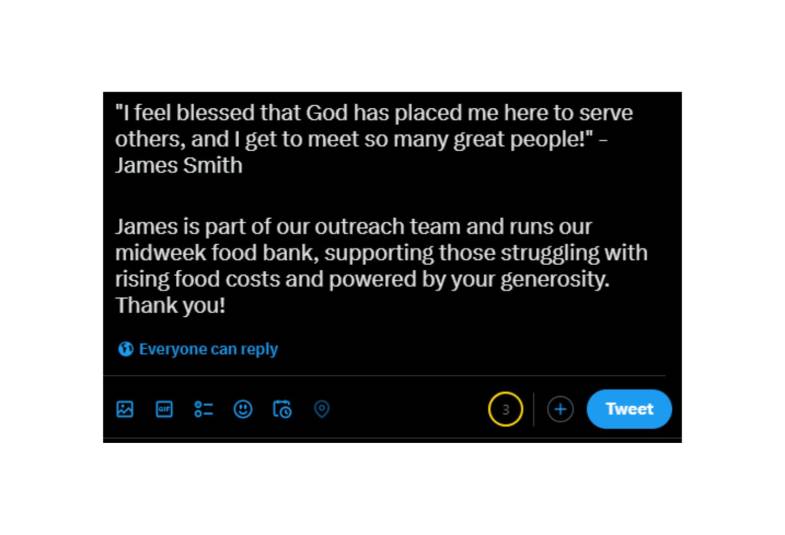05/10/2023
Figuring out how to best use social media for the benefit of your church community can be a minefield.
It can sometimes seem like there are so many other churches and charities using social media in a way that engages their communities and audiences at a standard that feels unreachable. It may be that they have in-house teams dedicated to their social output or that they have the means to outsource this work to a professional agency.
But in this blog, we’re going to cover a few key principles which will help you and your church to produce scroll-stopping copy of 280 characters or less – perfect for X (formerly known as Twitter) and great for Instagram and Facebook – to go alongside your graphics and photos.
Let’s get into using copy to captivate and inspire your congregation and its potential new members. These are a few things you’ll need to determine before you can get posting.
1. Figure out your social media purpose and creating your 'purpose slogan'
Ultimately, the aim of your social output should be to tell the story of your church. What are you all about? What is your church’s mission? Narrowing this down to a few words or a slogan that encapsulates why your church exists will really help you focus your social media content and message. Let’s call this your ‘purpose slogan’.
A way to create your purpose slogan could be to brainstorm some of the values that characterise your church community, or to look at your church’s mission statement (if you have one) and summarise it into a single snappy line. These slogans often (but don’t need to) feature in the short biography that sits at the top of a church’s social media page.
These are some existing examples:
- ‘For the people of East London’ – SAINT
- ‘Home in the heart of Oxford’ – St Aldate’s Church, Oxford
- ‘Following Jesus, Building Community, Loving Newcastle’ – St Thomas’ Newcastle
- ‘Everybody is welcome here’ – St Peter’s Brighton
- ‘You belong here’ – Harbour Church, Portsmouth
Whatever your purpose slogan, you may choose to use it front and centre on your social platforms, as a tagline by which your church can be recognised. ‘I’m loving it’ and ‘Every little helps’ are two great corporate examples of this working well – do you recognise them?
Or you may choose to keep it off your socials, but at the forefront of your process when developing your messaging, to make sure your copy is always centred around your church’s mission.
If using your purpose slogan on your social media, make sure it conforms to your tone of voice (more on that shortly). But how you use it is completely up to you.
At this stage, it is also good to determine whether your social media will function as a noticeboard for upcoming events, as a space for inspiration and evangelism, or both. This can change gradually over time, but having a clear function from the outset will help your followers know what to expect from your content each time they visit your page.
2. What is your tone of voice?
Your tone of voice is the way you use language to communicate with your audience. If you think of your church as a person, the words and phrases you use on your church’s social platforms share a lot about your church’s personality and character, just as you would learn when meeting someone new and hearing how they speak to others. First impressions count, and you want your audience’s impression of your church to be authentic. You also want to keep your tone of voice consistent across platforms and over time, so when people view your content again, they recognise who they are engaging with.
So, have a think about who you are as a church. Are you a traditional or more contemporary? Do you use colloquial language from the pulpit and when engaging with others or are you clear and direct? What is the overriding culture of your community? Which generation makes up the bulk of your congregation, or do people of all ages attend? And at what stage of life are those you’re trying to reach?
Deciding on your tone of voice and sticking to it when writing social content will foster a sense of continuity and trustworthiness across your output. Your online audience will know what they’re getting when they engage with your posts, and will get to know the personality of your church through the language you choose.
Understanding your church’s values can really help you determine what your tone of voice should be. Perhaps your key characteristics are community, generosity, and fun. You can create a sense of togetherness in your language by using ‘we’, ‘our’ and ‘us’ – this can also make those who are not yet fully a part of your church community feel welcomed and included. These collective pronouns, and diverse personal stories from your congregation of giving and serving the church and one another, can both build on your values of community and generosity.
Choosing snappy and colloquial language and using contractions (for example, ‘we’ll’ rather than ‘we will’), and even emojis, can build on the fun element (as well as keeping your copy short). Using positive language can make your followers feel good when reading your content, which boosts engagement and audience retention.
Top tip:
Every message you write on behalf of your church forms a narrative – be intentional about the story you decide to tell. Your copy should reflect the reality of your church – what those who have followed you on social media will experience when they step through your doors – but it can still have aspects of hope and aspiration for what you believe God is calling your community into. For example, if you say you are ‘welcoming to all’ on social media, but newcomers who follow your church’s social accounts aren’t engaged with on a Sunday, those people will walk away from your church. Language intentionality on social media is that important.
3. Develop some copy templates
There are likely a number of messages that you’ll want to drive home to your church community and potential joiners on a weekly basis. If you have a bank of templates (example posts), created once you distinguish your tone of voice, it will help you save time and energy in having to craft your messaging from scratch every single time you share a post. It can also help you come up with fresh ideas for formatting copy for new events or campaigns (i.e. to promote a teaching series or a parents-and-toddlers event, or to share what your church is doing to tackle climate change).
Here are a few examples based on the tone of voice example discussed in the previous step: emphasising your church’s characteristics of community, generosity and fun. These were crafted for X (formerly known as Twitter) and can be used across social platforms.
If you have graphic design with text to post alongside your copy, try not to repeat any messaging that’s within the image. Try to also use line breaks to make your text easier to read.



If posting about individuals from your church community, it helps to have their photo shared within the post (and it is essential to have their express permission to share their name, image and/or story on social media).
Top tip:
Use a character counter like this one to keep your posts to 280 characters or less, and use that same copy across your platforms to foster continuity, cohesion and an element of professionalism, and to encourage your audience to know what to expect from your church across platforms (and therefore in person).
And there you have it! Once you and your team have formulated your church’s social media purpose, your tone of voice, and your copy templates, you’ll be in an excellent position to confidently write copy that best serves your church’s mission, increases online engagement with your various social platforms, and translates online followers into weekly additions to your in-person congregation.
- Kimberley John, Digital Communications Manager


